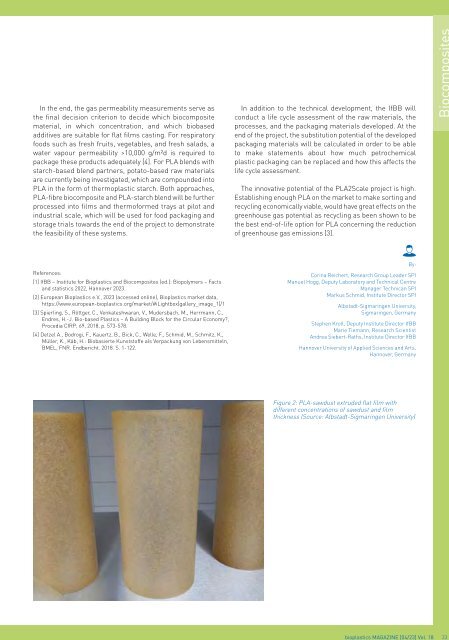Issue 04/2023
Highlights 100th issue Rebranding
Highlights
100th issue
Rebranding
Create successful ePaper yourself
Turn your PDF publications into a flip-book with our unique Google optimized e-Paper software.
ioplastics MAGAZINE [<strong>04</strong>/23] Vol. 18<br />
33<br />
In the end, the gas permeability measurements serve as<br />
the final decision criterion to decide which biocomposite<br />
material, in which concentration, and which biobased<br />
additives are suitable for flat films casting. For respiratory<br />
foods such as fresh fruits, vegetables, and fresh salads, a<br />
water vapour permeability >10,000 g/m²d is required to<br />
package these products adequately [4]. For PLA blends with<br />
starch-based blend partners, potato-based raw materials<br />
are currently being investigated, which are compounded into<br />
PLA in the form of thermoplastic starch. Both approaches,<br />
PLA-fibre biocomposite and PLA-starch blend will be further<br />
processed into films and thermoformed trays at pilot and<br />
industrial scale, which will be used for food packaging and<br />
storage trials towards the end of the project to demonstrate<br />
the feasibility of these systems.<br />
In addition to the technical development, the IfBB will<br />
conduct a life cycle assessment of the raw materials, the<br />
processes, and the packaging materials developed. At the<br />
end of the project, the substitution potential of the developed<br />
packaging materials will be calculated in order to be able<br />
to make statements about how much petrochemical<br />
plastic packaging can be replaced and how this affects the<br />
life cycle assessment.<br />
The innovative potential of the PLA2Scale project is high.<br />
Establishing enough PLA on the market to make sorting and<br />
recycling economically viable, would have great effects on the<br />
greenhouse gas potential as recycling as been shown to be<br />
the best end-of-life option for PLA concerning the reduction<br />
of greenhouse gas emissions [3].<br />
References:<br />
[1] IfBB – Institute for Bioplastics and Biocomposites (ed.): Biopolymers – Facts<br />
and statistics 2022, Hannover <strong>2023</strong>.<br />
[2] European Bioplastics e.V., <strong>2023</strong> (accessed online), Bioplastics market data,<br />
https://www.european-bioplastics.org/market/#iLightbox[gallery_image_1]/1<br />
[3] Spierling, S., Röttger, C., Venkateshwaran, V., Mudersbach, M., Herrmann, C.,<br />
Endres, H.-J. Bio-based Plastics – A Building Block for the Circular Economy?,<br />
Procedia CIRP, 69, 2018, p. 573-578.<br />
[4] Detzel A., Bodrogi, F., Kauertz, B., Bick, C., Welle, F., Schmid, M., Schmitz, K.,<br />
Müller, K., Käb, H.: Biobasierte Kunststoffe als Verpackung von Lebensmitteln,<br />
BMEL, FNR. Endbericht. 2018. S. 1-122.<br />
By:<br />
Corina Reichert, Research Group Leader SPI<br />
Manuel Hogg, Deputy Laboratory and Technical Centre<br />
Manager Technican SPI<br />
Markus Schmid, Institute Director SPI<br />
Albstadt-Sigmaringen University,<br />
Sigmaringen, Germany<br />
Stephen Kroll, Deputy Institute Director IfBB<br />
Marie Tiemann, Research Scientist<br />
Andrea Siebert-Raths, Institute Director IfBB<br />
Hannover University of Applied Sciences and Arts,<br />
Hannover, Germany<br />
Figure 2: PLA-sawdust extruded flat film with<br />
different concentrations of sawdust and film<br />
thickness (Source: Albstadt-Sigmaringen University)

















